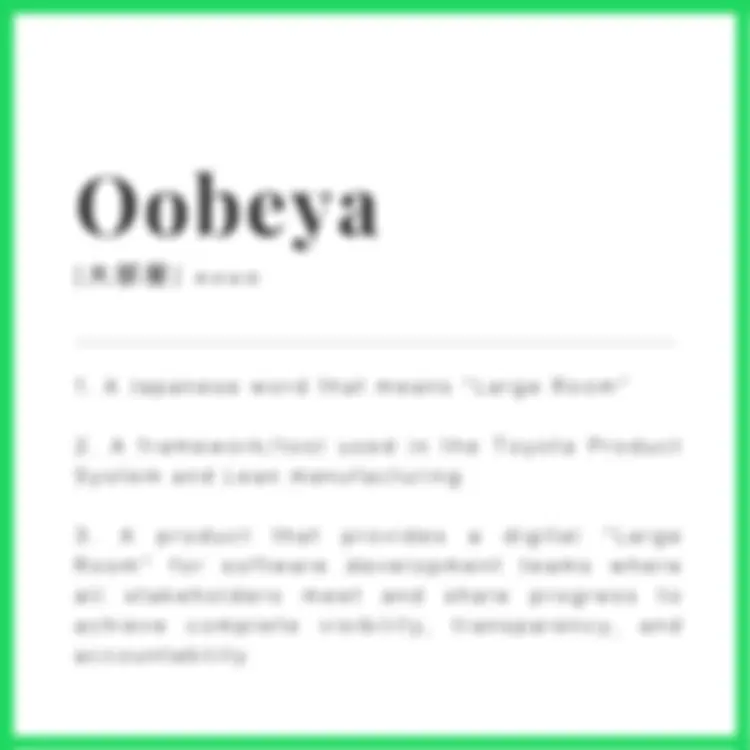Introduction
In today’s fast-paced software development world, engineering teams often struggle with misalignment, fragmented workflows, and a lack of clear visibility. These challenges can lead to inefficiencies, delays, and difficulties in decision-making.
Toyota encountered similar issues decades ago in its manufacturing process, where different teams operated in silos, leading to bottlenecks and wasted effort. To solve this, they introduced Oobeya—a collaborative space designed to improve transparency, coordination, and efficiency within the Toyota Production System (TPS).
The Oobeya approach created a centralized hub where teams could visualize work in progress, identify challenges early, and make informed decisions based on real-time data.
Today, Oobeya’s principles extend beyond manufacturing into software development, where teams navigate complex toolchains, distributed environments, and fast-moving projects. At Oobeya.io, we have transformed this concept into a modern Engineering Intelligence Platform, offering DevOps teams real-time visibility, actionable insights, and seamless collaboration to enhance software delivery performance.
But what exactly does Oobeya mean? And why did we choose this name for our platform?
 What Does Oobeya Mean?
What Does Oobeya Mean?
1. Oobeya: The Meaning Behind the Name
Oobeya (大部屋) is a Japanese word that means “Large Room”. It originated from Lean Manufacturing and was a critical part of Toyota’s Kaizen and Lean methodologies.
In the Toyota Production System, Oobeya was a dedicated space where cross-functional teams gathered to monitor progress, share critical updates, and solve bottlenecks in real-time. Instead of waiting for reports or relying on fragmented data, teams worked in one centralized, highly visual environment, using walls filled with charts, KPIs, and objectives.
The primary objectives of an Oobeya room include:
- Rapid decision-making with real-time visibility into processes.
- Reducing inefficiencies and rework by detecting issues early.
- Improving team collaboration by fostering alignment across departments.
“To eliminate waste, you need to change how you look at things. You must continuously refine your process, neither tiring nor ceasing.”
— Taiichi Ohno, Father of the Toyota Production System
This same principle is now being applied to software development.
2. Oobeya for Software Development: A Digital Large Room
At Oobeya.io, we have transformed the traditional Oobeya concept into a digital collaboration and analytics platform for DevOps teams. In modern software engineering, teams use multiple tools—GitHub, Jira, CI/CD pipelines, testing platforms, and monitoring solutions—but they often lack a unified accurate view of their software delivery performance.
Oobeya acts as the digital “Large Room” for software organizations, where all stakeholders—engineering leaders, developers, DevOps teams, and product managers—gain real-time visibility into engineering efficiency.
How Oobeya Solves Challenges for DevOps Teams:
- End-to-End Visibility: Oobeya aggregates engineering data from repositories, issue tracking tools, and CI/CD pipelines into a single real-time dashboard.
- Bottleneck Detection: The Symptoms Module proactively detects long cycle times, PR review delays, code quality issues, inefficient deployments, and many more providing actionable insights.
- Engineering Efficiency Metrics: Oobeya tracks essential DevOps performance metrics, including DORA Metrics, Agile Metrics, cycle time, lead time, Sprint accuracy, Developer productivity, and pull request efficiency.
- Security & Compliance: Teams can monitor change failure rates, security vulnerabilities, and incident response times to improve software delivery resilience.
- Data-Driven Decision Making: Move away from intuition-based management and leverage real-time engineering intelligence.
By unifying software development analytics, Oobeya eliminates silos, improves collaboration, and helps teams continuously optimize their software delivery process.
3. Oobeya in Accelerate: High-Performance Software Teams
In 2018, a book called Accelerate was published by Nicole Forsgren, Jez Humble, and Gene Kim. (Learn more about Accelerate and DORA Metrics.)
Steve Bell and Karen Whitley Bell wrote a chapter (Chapter 16 - High-Performance Leadership And Management) for the Accelerate book to share the Oobeya experiences of ING Netherlands. I highly recommend reading this chapter to explore the Oobeya experiences and practices of an IT organization.
4. Why Oobeya is the Future of Engineering Intelligence
Software engineering is evolving, and traditional performance-tracking methods are no longer enough. DevOps teams need real-time insights, cross-platform visibility, and automated issue detection to stay ahead.
What Sets Oobeya Apart?
- Cross-Platform Integration: Works seamlessly with GitHub, GitLab, Bitbucket, Jira, Azure DevOps, Jenkins, and more.
- Real-Time Accurate Insights: Provides continuous monitoring of software delivery performance to detect inefficiencies before they impact development.
- Comprehensive Metrics Dashboard: Tracks DORA Metrics, Agile Metrics, Developer Experience Metrics, Cycle Time, and Comparative Metrics for performance benchmarking.
- Security & Compliance Monitoring: Ensures risk-free deployments with built-in security tracking.
- Developer Experience (DevEx) Insights: Reduces friction, improves focus time, and enhances productivity.
Oobeya is not just an analytics tool—it is a true Software Engineering Intelligence Platform designed to help teams shift from reactive problem-solving to proactive optimization.
5. Take the Next Step: Transform Your DevOps Performance with Oobeya
Oobeya isn’t just a concept—it’s a game-changer for software teams. Oobeya helps teams improve efficiency, reduce risks, and accelerate value delivery by bringing visibility, data intelligence, and proactive insights into DevOps workflows**.**
📢 Want to see how Oobeya can transform your DevOps performance?
➡️ Book a Demo and experience!

